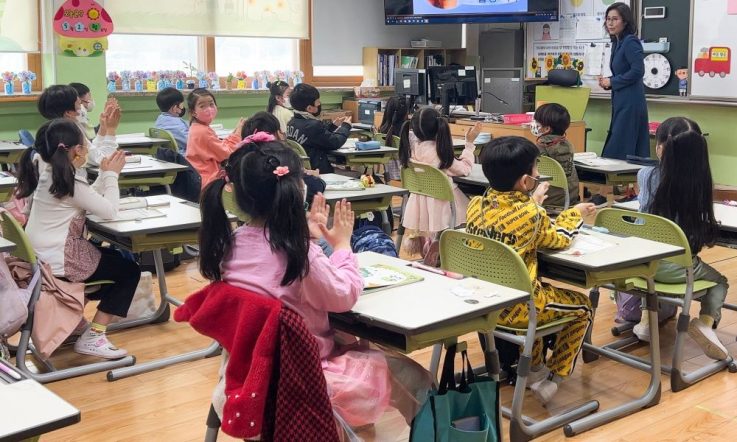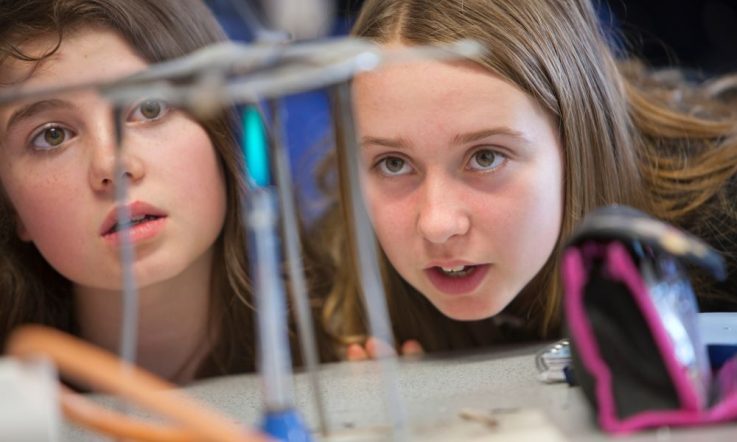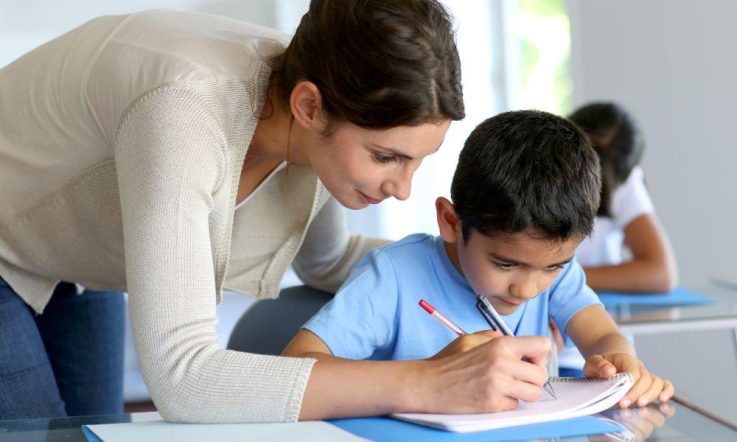This podcast from Teacher is supported by Grok Academy, a Digital Technology education platform free for Australian and New Zealand teachers and students.
Hello and welcome to this podcast from Teacher, I'm Jo Earp. My guest for this special miniseries is Professor Geoff Masters, CEO of the Australian Council for Educational Research. In his new book, Building a world-class learning system: insights from some top-performing school systems, he explores what's been happening in British Columbia, Estonia, Finland, Hong Kong and South Korea. In the first episode, we talked about the big questions that school systems around the world are grappling with, and we also looked at some of the reforms in these 5 jurisdictions, including the core characteristics of a world class curriculum. Last time out, we spoke about creating the conditions for all students to learn successfully, and so in this final episode, we're going to be looking at meeting individual student needs. I hope you enjoy the chat.
Jo Earp: Hi, Geoff, welcome back to Episode 3. Now in your book you explain that the 5 jurisdictions that you studied have all given a high priority to ensuring that every student has an opportunity to learn successfully. And of course, we know that it's about every student making progress and that requires teachers to know where individual students are in their learning, what the next steps are, and then how they can support them to continue to grow and progress.
Geoff Masters: Yes, Jo, I guess the first point here is that what one can see in these 5 jurisdictions is that there's a deep belief that every student can learn and can succeed. So that's a mindset issue, I guess. They don't begin by assuming that there are ‘good’ learners and ‘poor’ learners and that poor learners are never going to succeed. They really believe that every student should be able to make ongoing progress and eventually achieve high standards, if they can get the conditions right.
And they recognise that an important strategy for doing that is to understand where students are in their learning and meet them where they are. When I say that, I mean, yes, what they know, what they understand, what they can do, but I also mean where they're coming from, in terms of what interests them and motivates them and their backgrounds, their cultural backgrounds, language backgrounds and so on, anything that might influence their starting point for learning.
So, what's common across these jurisdictions, these 5 jurisdictions, is that they go to quite considerable lengths to do that, to understand where students are, to meet them where they are, to challenge and extend and stretch every student, and to expect every student to make good, ongoing progress in their learning.
JE: Mm-hmm. So, in your study, then – this is a multi-year study and you've looked at these 5 school systems – you analysed how they provide support to particular groups of students and individual learners who need it. I want to start with Finland, what happens in terms of monitoring and intervention, there? It's really interesting, isn't it?
GM: Yeah, Finland is interesting to me. Firstly, because what they do (and again, this is common across the country, it seems) what they do is they organise meetings, regular meetings, to talk about individual students. So, these are kind of multi-professional meetings that they will have. They might, well, they would involve the classroom teacher, but they would involve someone who heads the curriculum area, they might involve a social worker or a nurse; they truly are multidisciplinary. And they will talk about individual students and what progress they're making and whether there are particular issues or challenges that need to be addressed; and they will, of course involve parents then, if they need to, they’ll involve parents in the conversation as well.
But the other thing they do that I think is really interesting is they have teachers who are specially trained to work with students who are beginning to slip behind in their learning. And they have a lot of these teachers; that is their sole job: to work with students who need additional support. That support might be provided by going into the classroom and working with students, or it might involve withdrawing a student or group of students from the classroom and working with them in in a more intensive way. So, they work with classroom teachers but they're not classroom teachers, they have this special role.
And what I've heard is that something like 30% of all students in Finland might work with one of these special teachers at some point during their schooling. So, it's not just for, you know, a handful of students who need it, it's for any student who's beginning to slip behind.
And I guess there's a more general point I could make here and that is, across these 5 school systems, what I see is that they take seriously the question of catching students who are starting to struggle and trying to get them back on track as quickly as they can. They have different ways of doing that, but in Finland it involves these multi-professional meetings regularly, that I mentioned, and also these specially trained teachers, who work with students who need additional support.
JE: Of course, the consequence of that is that they keep falling further and further behind. They go through primary school further and further behind, they can’t catch up, they get to secondary school, then we're into serious problems, aren’t we?
GM: Well, that's the case in many countries, that's right. If you don't have something in place to catch students and to try to get them back on track; if you have a system that just sorts students out over time, as each curriculum becomes harder and harder for them, increasingly out of their reach, then you've designed a system that almost guarantees a percentage of students are going to fail. But these jurisdictions are very determined to minimise the percentage of students who slip behind in their learning and end up not achieving minimally adequate standards.
JE: Yeah. So important to catch it just as it's happening. The other thing I want to just reiterate is in the last episode, we mentioned these are all these are all supports at a system-wide level. So, it's not just, you know, a couple of schools doing this, this is right across the country. And as you say there, it's interesting 30% of students will access these kinds of teachers in Finland. You also highlight how British Columbia is supporting students from minority backgrounds, including Indigenous and immigrant students, and we spoke a little bit about that in the last episode. Then in Estonia, there's also an important role for out-of-school learning, isn't there?
GM: Yes, yes, I found Estonia interesting because of the amount of learning that actually occurs outside the school, outside school hours. They have a whole range of organisations and institutions that provide learning opportunities for students. Often the programs they provide, like a museum or a nature centre … are often aligned with the school curriculum, so they're actually coming in behind the school curriculum and reinforcing the intended outcomes of the curriculum through the programs that the museum offers, or the nature centre offers.
So, a whole range of hobby schools, clubs, IT companies often play a role in this, so there's quite a strong ecosystem that sits around the work of schools and supports the work of schools in Estonia.
And schooling is very, very highly valued in that country. Parents are very supportive. Students are often under pressure and working long hours, I have to say. All this out of school learning takes a toll, I'm sure. There's an expectation that students will engage in extra-curricular activities outside school hours. There's an expectation that on top of that they'll be doing homework. So, they spend considerable time doing that.
But the point that I was trying to make is that there is a supporting ecosystem that comes in behind the work of schools and appears to be quite influential.
JE: So, schools are not just working in isolation then. Similarly in Hong Kong, then, there's a complex network of community support for schools, isn't there?
GM: Yes, yes, that's right. Again, Hong Kong is a jurisdiction that has an interesting structure around schools. Hong Kong refers to ‘lifelong and life-wide learning’. And by that it means, lifelong of course means learning is an ongoing continuous process, that continues throughout life, and when they say life-wide, what they mean is that it doesn't just occur within the boundaries of the school, learning occurs everywhere in the community.
So, they talk about experiential learning, providing students with opportunities to undertake career-related activities and experiences, to get engaged in community service activities. They see these activities outside the school as being important contributors to the moral and civic development of young people. So yes, you're right, they do, in Hong Kong, draw on a range of organisations, associations, players in the community. And they also work fairly hard at building networks across schools, promoting professional learning communities across schools in Hong Kong.
JE: So, it's not again, as we say, not just individual teachers, individual teams of staff doing it on their own. ‘Lifelong and life-wide’, I like that one. The other thing that's important here is individual learner need, that word ‘individual’. But not all students from a particular group or a particular cohort have the same needs. So, as we know, trying to infer that from the group that they're a part of, let's take year 10 students, for example, that just doesn't work, does it?
GM: No, I think if we try to infer what a student needs, as you said, from the group to which they belong – whether it's that they're boys or girls, low socioeconomic background, Indigenous students, year 8 students or year 10 students – you're going to get it wrong for many students, because not all students in a group have the same needs. In fact, when you look at it carefully, they often have very, very different needs, within the group. Students from low socioeconomic backgrounds, for example, sometimes perform at very high levels, and students from high socioeconomic backgrounds sometimes perform at very low levels. There's a correlation, of course but you still have the exceptions.
What we can see in each year of school is that the most advanced students in the year group are about 5 or 6 years, usually 5 or 6 years of learning, ahead of the least advanced 10% of students. So that's huge variability that teachers have to deal with and if we just assume that we know, for example, what mathematics a year 9 student is ready to learn from the fact that they're in year 9, we can often get that very wrong, very wrong for some students.
You can see that in the latest PISA results. There are many students who are getting to 15 years of age in Australia but still lack some basic understandings of mathematics that they really should have developed years before. So, they've missed out at some point and no doubt slipped further behind. And, you know, it's interesting to think about what their experience of the year 9 Mathematics Curriculum was, or year 10 Mathematics Curriculum is, given those gaps.
So, I guess the point I'm making, Jo, is that we have a very traditional model of learning in our schools, that is based on the assumption, largely, that we know what a person's ready to learn because we know their age, or because we know their year level. We have what people sometimes call an industrial model or an assembly line model of schooling, where we bunch students by age, we group them by age, largely, we teach them the same things at the same time for the same amount of time, we then assess them, we grade them on how much of that taught material they can demonstrate and then they move on in unison to the next body of content, where the whole process is repeated. So, it is like an assembly line when you think about it, that’s the way we organise learning.
But we also know, and it's very clear in these latest PISA results, we know that a consequence of that is that many students slip behind and it's obvious why. They're required to move on to the next curriculum, not because they've mastered the prior curriculum, but because time’s up – we have a time-based system. And so, many students are moving on to the next curriculum not having the prerequisites that they will need for what they're expected to learn next. And the consequence of that, as I say, is often that they just slip further behind the longer they're in school.
So, this I think is a real challenge for us in our schooling, to think about how we introduce more flexibility into our learning arrangements so that we can better target the needs of individual learners.
We'll be back from more from Professor Geoff Masters after this quick message from our sponsor.
You’re listening to a podcast from Teacher magazine, supported by Grok Academy. Grok Academy is a not-for-profit Digital Technologies platform with resources for coding and cyber security, for Foundation to Year 10 – and it's completely free for Australian and New Zealand teachers and students.
JE: OK, welcome back to Episode 3. I want to read a quote from your book, this is from the British Columbia Ministry of Education. ‘Personalised learning recognises that no 2 students learn the same way or at the same pace. It also recognises that for students to succeed in school and to succeed after graduation, they must be engaged and invested in their learning. This means individual learning that is focused on the needs, strengths and aspirations of each individual young person. In a system that values personalised learning, students play an increasingly active role in designing their own education path as they develop and mature, while being held increasingly accountable for their own learning success.’ So, all the learning jurisdictions that you studied in the book recognised the importance of meeting these individual learning needs. As we mentioned right at the beginning of the episode, that means teachers need to know where students are in their learning. One of the examples of reform that you give in this area is Estonia’s professional standards for teachers, isn't it?
GM: Yes, yes. So, what you can see in Estonia and in one or 2 other jurisdictions as well, is that they are building into their expectations for teachers (in this case the 2019 revision of the Estonian Teacher Standards), they're building in the expectation that teachers will do exactly what you've just described: that they will develop skills in analysing, diagnosing, understanding where individual students are in their learning, and then design learning opportunities that are well-targeted on student needs.
The opposite of that is a mindset that says: ‘I'm here to deliver the curriculum. So, my job is to stand at the front of the room (I'm not suggesting anybody actually does this, but it's the extreme), where I just come into the room and I deliver the same curriculum to everybody and the onus is on the students to learn what I deliver and then I assess them to see how well they've done that’.
So, as you say, teaching standards in many countries, are now recognising that teaching is not a matter of delivery. It's much more difficult than that. It's a real professional activity, where teachers work to understand what they're dealing with, what the confronting situation is, where individual students are at in their learning and how they can best meet their current needs, understand the difficulties they're experiencing, understand the misunderstandings they've developed, for example, or the gaps in their learning, and then doing what they can to target those misunderstandings or gaps to promote each individual’s further growth. So yes, this is this is something that teaching standards are increasingly incorporating.
JE: Mm-hmm. And you've spoken before about, you know, teachers requiring support in this area, because it's incredibly complex, isn't it?
GM: Yes, yes, absolutely. Teachers require support of various kinds. Often, dealing with the variability in a particular classroom is beyond the capacity of one teacher. It often requires teachers to collaborate in that, or other kinds of support for teachers.
But there are other things that can be done to support teachers as well. Like providing good support in establishing where students are in their learning. Some of these jurisdictions, like Korea, develop diagnostic assessments that they make available to all teachers for that purpose of better understanding the points that students have reached in their learning. Providing resources, online these days of course, but providing quality teaching and learning resources, that are well targeted on student needs.
JE: And another approach to helping gain that deeper understanding and really knowing individual students is keeping the same teacher, isn't it? There are some interesting examples from those jurisdictions.
GM: Yes, it is interesting, because this is not common practice in most countries, I think. But if you look at Finland and you look at Estonia, what you can see is that it is common practice, if not standard practice, for teachers to remain with the same students over a number of years. So, the same teacher might remain with the same class, not only in year 1 but year 2,3,4, and [sometimes] in Estonia, right through to the end of year 6. So, the advantage, the perceived advantage of that is that the teacher gets to know individual students in great depth and is better able to monitor the progress they're making and ensure that their needs are being met.
So, that's one strategy that these jurisdictions use. Something else, Jo, that I might just mention is, since I was thinking about Finland, another strategy is to define a broader phase of school. So, Finland, as I understand it, is in the process of defining a phase of school that runs from, you know, kindergarten through to year 2 or 3. I can't remember how many years it is but there's a 3- or 4-year phase of school. And rather than saying ‘this child is in year 1 so I need to teach them the year 1 curriculum’, within that phase, they recognise that children can be at very different points in their learning and development. So, there could be a 7-year-old who's still reading like the average year like the average 5-year-old, for example. So, the whole purpose of that broader phase is to support teachers and encourage teachers to identify where individual students are and to try to target the learning opportunities that they provide to meet the needs of those children.
JE: And once we know where students are in their learning, of course, you can then think about that kind of targeted teaching – you can think about those stretch challenges that we know are so important for learning growth. There are some really good examples of targeted teaching and intervention in the book and how these individual learning needs are being met. So, I thought, to finish off the episode then, can you share some of those with listeners?
GM: Yes. So, it's partly a matter of summarising some of the things we've just been talking about. There are a whole lot of things that these jurisdictions do in an attempt to better target the needs of individual students. So, we talked about keeping the same teacher over a number of years of school to better understand and target student needs. The idea of broader phases of schooling that we were just talking about, again for that purpose.
Providing assessment, quality assessment materials, not for the purpose of saying ‘how well have you learned the year 4 curriculum?’ but, ‘where are you up to in your reading?’, ‘Where are you up to in your mathematics?’, ‘Are you, you know, 2 years ahead of age level expectations? Are you 2 years behind?’, ‘Where exactly are you up to and how can I better target my teaching to address your needs’.
The idea of specially trained teachers who can go in and target teaching, where individuals are; rather than having them just taught the same things as everybody else in the class, let's understand the needs of individual students, where they're at, what they haven't understood and try to address those needs.
Small group teaching. You know, Estonia doesn't have the resources to do what Finland does in terms of specially trained teachers, but what they do is to withdraw students and teach them in small groups, about 8 students for example. So, if they're struggling, they will pull them out of the class and have somebody work with them to get them back on track.
There are out-of-school clinics, you know, learning clinics, as in Korea, to better address the needs, particularly of disadvantaged groups, in the community.
And then there are really radical things that people are attempting as well, not so much within these 5 jurisdictions, but if you look at places like Wales and Scotland and to some extent, New Zealand, they are radically rethinking how they organise learning at school. So, they're trying to find ways of breaking out of the rigid, time-based, assembly line model. How can we move to ways of structuring, organising learning so that we can better identify where students are up to and better meet their needs?
So, in Wales, just to finish what I started, in Wales, rather than saying ‘you're in year 7 so I'll teach you the year 7 curriculum’, they have a set of levels that students move through, in say, mathematics, and they understand that not all students in year 7 will be working at the same level at the same time and that there’ll be, you know, different students at different levels. But the point is, by having every student work through the same set of levels, with the possibility of them, you know, moving at different rates as well, that there's a better opportunity to target the needs of individual students.
So, there are lots of things that countries, including these 5 high performing jurisdictions, there are lots of things that countries are trying for the purposes of better understanding, identifying and addressing the needs of all learners.
Well, sadly, that's all for this episode – and it's the last episode of the series, but it's been it's been fantastic hearing more about the study by Professor Geoff Masters. This miniseries of course, that’s just a taste of those findings, there's a lot more in the book. A reminder that one is called Building a world-class learning system: insights from some top-performing school systems. So, just type that into your search engine to access a digital copy which you can download for free from the ACER Research Repository and I'll also pop a direct link in the transcript of this podcast. If you want to keep listening now there are 300 more episodes to binge on in the Teacher archives. And one final request before I go, please take a moment to leave a rating and review – it helps other people like you to find the podcast and it’s a great support for the Teacher team.
You’ve been listening to a podcast from Teacher, supported by Grok Academy. You can create a free account and get access to a huge range of coding and cyber security resources at Grok Academy. You can visit GrokAcademy.org, or simply search for Grok Academy.



